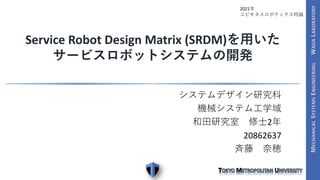
Service Robot Design Matrix (SRDM) を用いたサービスロボットシステムの開発
- 1. システムデザイン研究科 機械システム工学域 和田研究室 修士2年 20862637 斉藤 奈穂 Service Robot Design Matrix (SRDM)を用いた サービスロボットシステムの開発 2021年 ユビキタスロボティクス特論
- 2. 1. 研究背景・目的 2. 提案ツール「 Service Robot Design Matrix (SRDM) 」 3. 作業内容 Outline
- 3. サービスロボットの需要 The demand for Service Robots ► 人とインタラクション+様々な環境下+複雑で自律した動作=多様なサービスを提供 Service robots provide a variety of services while interacting with people, and making complex and autonomous motions in various environments ► 介護や小売分野などで深刻な人手不足→様々なサービス分野でサービスロボットの活躍に期待 The demand for Service Robots is expected to increase further 研究背景と目的 Background and goal of this study タスク・要求が明確 Tasks and requirements are clear (川崎重工) Industrial Robots 物流・自律走行型配送ロボット (RICE・アスラテック) 家庭内清掃・ロボット掃除機 (Roomba・iRobot) 介護・メンタルコミットロボット (Paro・産業技術総合研究所) Service Robots サービスロボットの社会への普及は限定的 the majority of service robots do not reach the market タスク・要求が多種多様で不明確 Tasks and requirements are diverse and unclear
- 4. サービスロボット開発 これまでのロボット ▶ ロボットが実行できるタスクが中心・「技術起点」によって開発 Most of today’s robot developments often seem to be guided by not interaction, or social aims, but by the technical feasibility, the type and tasks a robot can perform これからのサービスロボット ▶ どこで,どのように活躍できるか考慮して開発することが求められる For future Service Robot Development, It is important to design service robots considering the needs of the targeted users and context of use • ロボットの機能 + ロボットが使用される文脈を考慮した設計 • 企画・構想と概念設計を行う上流設計の重要性 研究目的 Goal of this study ロボットが使用される文脈を考慮したサービスロボットの開発を支援するツールの開発 Developing a framework for designing service robots which considering the needs of the targeted users and context of use as well as the technical feasibility 研究背景と目的 Background and goal of this study Fig. ロボット開発のV字モデル 問題点 サービスロボットの上流設計を行うための標準化された方法が存在しない There is not a standardized design platform for service robots considered context of use of robots as well as robot functions
- 5. Service Robot Design Matrix (SRDM) ► サービスシステム全体を考慮したロボットシステムの設計検討を行うためのフレームワーク A framework to design robot systems considering the entire service system ある要素を何らかの理由で変更したとき,その影響先を辿ることが可能 When an element is changed for some reason, it is possible to trace the influence of the change 提案ツール「 Service Robot Design Matrix (SRDM) 」 Task Context Robot System Task A 1 1 1 B 1 C Context D 1 E 1 1 1 F Robot System 1 1 G 1 H I B 1 1 F 1 C G 1 1 1 1 A 1 1 D H 1 1 E I クラスタリング clustering 遺伝的アルゴリズム &局所探索法 genetic algorithm & local search 要素の集合, 集合間のインターフェースを確認 マトリクス上で 設計要素間の相互作用をマップ化
- 6. Keyword ► フレームワーク Frameworks – 検討すべき項目やポイントをパターンとして落としこんで考えるための枠組み – 当てはめた情報が整理され,目的達成への道筋を見つけやすくなる – A framework for thinking of items and points to be considered in a pattern – The information you apply is organized, making it easier to find a path to achieve your goals ► マトリクス Matrix – 縦軸と横軸に分析したい要素が記述された行列形式の表のこと – 関係性を持つ要素の行と列が交差する箇所に書き込みをすることで要素間の依存関係の分析が可能 – a square matrix (it has an equal number of rows and columns) that shows relationships between elements in a system ► クラスタリング Clustering – ある集合を何らかの規則によって分類すること – 互いに依存関係の強い要素同士の特定が可能 – Classifying a set according to some rule – It is possible to identify elements that have strong dependencies with each other 提案ツール「 Service Robot Design Matrix (SRDM) 」
- 7. テーマ Theme ► Service Robot Design Matrix (SRDM)で開発するロボットシステムの要求分析を行う Create Service Robot Design Matrix (SRDM) for requirements analysis of the robot system アウトプット Output ► SysML+Service Robot Design Matrix (SRDM) 作業の概要:テーマ Today's work Fig. Example of SRDM
- 8. 1. ロボットシステムの設計要素をリスト化する ► 指定するカテゴリー表を参考に作成(次のスライド) 2. リスト化した要素を正方行列の行と列に並べる 3. 依存関係のある要素の交点にマークを記入する ► 要素間で関係がないものにはマークをつけない 作業の概要:マトリクスの作り方 How to create SRDM 1. Make a list of design elements for the robotic system • Create the list with reference to the category table to be specified (next slide) 2. Arrange the listed elements in the rows and columns of a square matrix 3. Mark the intersection points of the elements that have dependencies • Do not mark elements that are not related to each other
- 9. 作業の概要:マトリクスの作り方 How to create SRDM 1.ロボットシステムの設計要素をリスト化する Make a list of design elements for the robotic system Category Subcategory Definition Task Usecase システムが遂行する単位業務 The unit task that the system performs Context Who タスクを実行するもの Who execute the task Whom タスクの対象となるもの・受給者 The recipients of the task Time タスクが実行される時間 Time at which the task will be performed Location タスクが実行される場所 Where the task is to be performed Why タスクを実行する目的 Purpose for performing the task Physical Elements タスクを実行する際に関与する製品や設備 Products or equipment involved in executing the task Robot System Appearance Design ロボットシステムの見た目のデザイン The visual design of the robotic system Functional Design タスクを実行するために必要なロボットシステムの機能 Functions of the robotic system required to execute the task Mechanical Design タスクを実行するために必要な機能実現のためのロボットシステムの機械設計 Mechanical design of the robotic system to realize the functions Interaction Design ロボットシステムと受給者の間に発生するインタラクションのデザイン Design of the interactions that will occur between the robotic system and the recipients Table. SRDMのカテゴリー表
- 10. カテゴリー表の埋め方のポイント • カテゴリー内の要素数は,システムの大きさに依存 • Taskのカテゴリーは,ユースケース図のユースケースと同様 で良い • それぞれのユースケースごとに,ContextやRobot Systemを考 える • The number of elements for each category depends on the size of the system • The categories of Task can be the same as the use cases in the use case diagram(SysML) • For each use case, consider the Context and Robot System 作業の概要:例 Examples
- 11. 2.リスト化した要素を正方行列の行と列に並べる Arrange the listed elements in the rows and columns of a square matrix 作業の概要:マトリクスの作り方 How to create SRDM 作成したカテゴリー表 the listed elements
- 12. 3.依存関係のある要素の交点にマーク「1」を記入する Mark「1」 the intersection points of the elements that have dependencies 関係している要素の交点に「1」と入力 Mark「1」 the intersection points of the elements 作業の概要:マトリクスの作り方 How to create SRDM
- 14. 行と列は同じ要素のため,入力は下三角部分だけでOK Rows and columns are the same element, so only the lower triangle is needed for input 関係している要素の交点に「1」と入力 Mark「1」 the intersection points of the elements
- 15. ここまでできたら,完成したマトリクスをkibacoに提出(提出日は6/16を予定) When you are done, submit the completed matrix to kibaco 後日,マトリクスをクラスタリングした結果を配布 → 結果を参考にロボット開発 Later, distribute the result of clustering the matrix → Develop the robot based on the result 作業の概要:マトリクスの作り方 How to create SRDM Task Context Robot System Task A 1 1 1 B 1 C Context D 1 E 1 1 1 F Robot System 1 1 G 1 H I B 1 1 F 1 C G 1 1 1 1 A 1 1 D H 1 1 E I クラスタリング 遺伝的アルゴリズム &局所探索法
- 16. 綱引きをする 勝敗を決定する